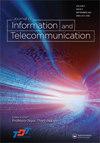Feature selection in intrusion detection systems: a new hybrid fusion of Bat algorithm and Residue Number System
IF 1.7
Q2 COMPUTER SCIENCE, INFORMATION SYSTEMS
Journal of Information and Telecommunication
Pub Date : 2023-11-06
DOI:10.1080/24751839.2023.2272484
引用次数: 0
Abstract
This research introduces innovative approaches to enhance intrusion detection systems (IDSs) by addressing critical challenges in existing methods. Various machine-learning techniques, including nature-inspired metaheuristics, Bayesian algorithms, and swarm intelligence, have been proposed in the past for attribute selection and IDS performance improvement. However, these methods have often fallen short in terms of detection accuracy, detection rate, precision, and F-score. To tackle these issues, the paper presents a novel hybrid feature selection approach combining the Bat metaheuristic algorithm with the Residue Number System (RNS). Initially, the Bat algorithm is utilized to partition training data and eliminate irrelevant attributes. Recognizing the Bat algorithm's slower training and testing times, RNS is incorporated to enhance processing speed. Additionally, principal component analysis (PCA) is employed for feature extraction. In a second phase, RNS is excluded for feature selection, allowing the Bat algorithm to perform this task while PCA handles feature extraction. Subsequently, classification is conducted using naive bayes, and k-Nearest Neighbors. Experimental results demonstrate the remarkable effectiveness of combining RNS with the Bat algorithm, achieving outstanding detection rates, accuracy, and F-scores. Notably, the fusion approach doubles processing speed. The findings are further validated through benchmarking against existing intrusion detection methods, establishing their competitiveness.入侵检测系统中的特征选择:一种新的Bat算法与剩余数系统的混合融合
本研究通过解决现有方法中的关键挑战,介绍了增强入侵检测系统(ids)的创新方法。过去已经提出了各种机器学习技术,包括自然启发的元启发式、贝叶斯算法和群体智能,用于属性选择和IDS性能改进。然而,这些方法在检测准确率、检出率、精密度和f分数方面往往存在不足。为了解决这些问题,本文提出了一种将Bat元启发式算法与剩余数系统(RNS)相结合的混合特征选择方法。首先利用Bat算法对训练数据进行分割,剔除不相关属性。考虑到Bat算法的训练和测试时间较慢,引入RNS来提高处理速度。此外,采用主成分分析(PCA)进行特征提取。在第二阶段,排除RNS进行特征选择,允许Bat算法执行此任务,而PCA处理特征提取。随后,使用朴素贝叶斯和k近邻进行分类。实验结果表明,RNS与Bat算法相结合的效果显著,检测率、准确率和f分数都很好。值得注意的是,融合方法将处理速度提高了一倍。通过对现有入侵检测方法的基准测试,进一步验证了研究结果,从而确立了它们的竞争力。
本文章由计算机程序翻译,如有差异,请以英文原文为准。
求助全文
约1分钟内获得全文
求助全文
来源期刊
CiteScore
7.50
自引率
0.00%
发文量
18
审稿时长
27 weeks

 求助内容:
求助内容: 应助结果提醒方式:
应助结果提醒方式:


